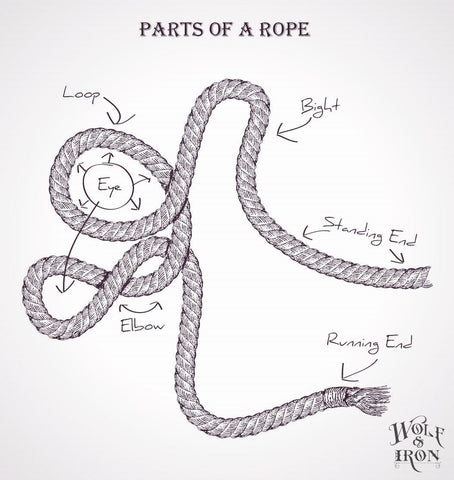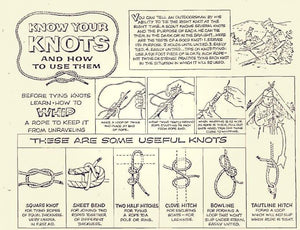Knot tying is a skillset that every man should possess but fewer and fewer of us do. In a day and age of bungees and tie down straps, ropework is less common. If you throw in the general white collar working conditions of our modern world it’s plain to see why this once necessary skill is being lost.
To quote the featured image from one of the initial Boy Scout publications (for which the full image can be found here):
“You can tell an outdoorsman by his ability to tie the right knot at the right time. A Scout knows several knots and the purpose of each.” – Scout Camping Skills Publication
There are loads of wonderful sites and videos on knot tying so I am not going to attempt to recreate them all. In fact, most publications are overwhelming on the subject. In the knot tying articles that follow, my goal is to point out only a few knots and when to use them.
Parts of a Rope
When discussing ropework it is helpful to understand the parts of a rope as it relates to knot tying. A nearly complete list of knot terms can be found here.
(Click the image below for the larger size.)

Parts of a Rope
Standing End
Part of the rope not actively being used for knot tying or the job at hand. Typically this is tied off somewhere or represents a bundle of cord.
Bight
A bend in the rope
Loop
A section of rope that makes a loop ;-)
Eye
The inner portion of a loop
Elbow
A section of nearby crossings in a rope. An Elbow is made by twisting a loop.
Running End
Also called Working End or Working Part is the other end of the rope opposite the Standing End.
Knot Categories
Breaking knots down by a few categories makes it easier to remember them and understand their general purpose which can usually be inferred by their name.
Bends
Used for joining two lines. Imagine you don’t have a long enough rope for the task at hand but have two pieces that, if put together, would get the job done. You need a bend knot of some sort.
Lashing
Used to hold objects together. Think about a teepee frame where the top of the poles are lashed together.
Loops
Knots used to make a fixed loop in a line.
Slip
Knots with a loop that constricts and loosens. Not to be confused with a Slipped knot which refers to the ease the untying of a knot much like a shoe string knot.
Whipping
Generally used to keep the end of a rope from fraying but can be used to constrict a bundle of items, like sticks, or when wrapping the handle of an item with cordage.
Final Thoughts
Upcoming articles will feature knots from the categories above which I believe offer the most practical usage and versatility. If you have any favorite knots let me know and it may make the list.

